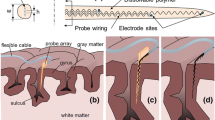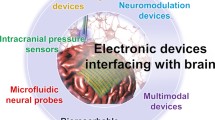Abstract
We present a microfabricated neural catheter for real-time continuous monitoring of multiple physiological, biochemical and electrophysiological variables that are critical to the diagnosis and treatment of evolving brain injury. The first generation neural catheter was realized by polyimide-based micromachining and a spiral rolling packaging method. The mechanical design and electrical operation of the microsensors were optimized and tailored for multimodal monitoring in rat brain such that the potential thermal, chemical and electrical crosstalk among the microsensors as well as errors from micro-environmental fluctuations are minimized. In vitro cytotoxicity analyses suggest that the developed neural catheters are minimally toxic to rat cortical neuronal cultures. In addition, in vivo histopathology results showed neither acute nor chronic inflammation for 7 days post implantation. The performance of the neural catheter was assessed in an in vivo needle prick model as a translational replica of a “mini” traumatic brain injury. It successfully monitored the expected transient brain oxygen, temperature, regional cerebral blood flow, and DC potential changes during the passage of spreading depolarization waves. We envisage that the developed multimodal neural catheter can be used to decipher the causes and consequences of secondary brain injury processes with high spatial and temporal resolution while reducing the potential for iatrogenic injury inherent to current use of multiple invasive probes.








Similar content being viewed by others
References
A. P. Alivisatos et al., Nanotools for neuroscience and brain activity mapping. ACS Nano 7, 1850–1866 (2013)
C. Ayata, M. Lauritzen, Spreading depression, spreading depolarizations, and the cerebral vasculature. Physiol. Rev. 95, 953–993 (2015)
B. Bosche et al., Recurrent spreading depolarizations after subarachnoid hemorrhage decreases oxygen availability in human cerebral cortex. Ann. Neurol. 67, 607–617 (2010)
P. Bouzat et al., Accuracy of brain multimodal monitoring to detect cerebral hypoperfusion after traumatic brain injury. Crit. Care Med. 43, 445–452 (2015)
G. Buzsáki et al., Tools for probing local circuits: high-density silicon probes combined with optogenetics. Neuron 86, 92–105 (2015)
C. Dohmen et al., Spreading depolarizations occur in human ischemic stroke with high incidence. Ann. Neurol. 63, 720–728 (2008)
J. P. Dreier, The role of spreading depression, spreading depolarization and spreading ischemia in neurological disease. Nat. Med. 17, 439–447 (2011)
J. Du et al., Multiplexed, high density electrophysiology with nanofabricated neural probes. PLoS One 6, e262014 (2011)
Z. Fekete, Recent advance in silicon-based neural microelectrodes and microsystems: a review. Sensors Actuators B Chem. 215, 300–315 (2015)
A. Frazier, Recent applications of polyimide to micromachining technology. IEEE Trans. Ind. Electron. 42, 442–448 (1995)
J. Frontera et al., Regional brain monitoring in the neurocritical care unit. Neurocrit. Care. 22, 348–359 (2015)
M. HajjHassan et al., NeuroMEMS: neural probe microtechnologies. Sensors 8, 6704–6726 (2008)
J. A. Hartings et al., Spreading depolarizations and outcome after trauamtmic brain injury: a prospective observational study. Lancet Neurol. 10, 1058–1064 (2011)
C. Hassler et al., Polymers for neural implants. J. Polym. Sci. Polym. Phys. 49, 18–33 (2011)
J. M. Hinzman et al., Inverse neurovascular coupling to cortical spreading depolarizations in severe brain trauma. Brain 137, 2960–2972 (2014)
J. Jeong et al., Soft mateials in neuroengineering for hard problems in neuroscience. Neuron 86, 175–186 (2015)
W. S. Lau et al., The application of polyimide/silicon nitride dual passivation on AlxGa1-xN/GaN high electron mobility transistors. Microelectron. Reliab. 48, 187–192 (2008)
M. Lauritzen et al., Clinical relevance of cortical spreading depression in neurological disorders: migraine, malignant stroke, subarachnoid and intracranial hemorrhage, and traumatic brain injury. J. Cereb. Blood Flow Metab. 31, 17–35 (2011)
A. A. P. Leão, Spreading depression of activity in the cerebral cortex. J. Neurophisiol. 7, 359–390 (1944)
C. Li et al., Flexible biosensors on spirally rolled micro tube for cardiovascular in vivo monitoring. Biosens. Bioelectron. 22, 1988–1993 (2007)
C. Li et al., A flexible polymer tube lab-chip integrated with microsensors for smart microcatheter. Biomed. Microdevices 10, 671–679 (2008)
C. Li et al., A novel lab-on-a-tube for multimodality neuromonitoring of patients with traumatic brain injury (TBI). Lab Chip 9, 1988–1990 (2009a)
C. Li et al., Toward real-time continuous brain glucose and oxygen monitoring with a smart catheter. Biosens. Bioelectron. 25, 173–178 (2009b)
C. Li et al., Dual-mode operation of flexible piezoelectric polymer diaphragm for intracranial pressure measurement. Appl. Phys. Lett. 96, 053502 (2010)
C. Li et al., Smart catheter flow sensor for real-time continuous regional cerebral blood flow monitoring. Appl. Phys. Lett. 99, 233705 (2011)
C. Li et al., Brain temperature measurement: a study of in vitro accuracy and stability of smart catheter temperature sensors. Biomed. Microdevices 14, 109–118 (2012a)
C. Li et al., Micromachined lab-on-a-tube sensors for simultaneous brain temperature and cerebral blood flow measurements. Biomed. Microdevices 14, 759–768 (2012b)
C. Li et al., Highly accurate thermal flow microsensor for continuous and quantitative measurement of cerebral blood flow. Biomed. Microdevices 17, 87 (2015)
C. Li et al., Single probe for real-time simultaneous monitoring of neurochemistry and direct-current electrocorticography. Biosens. Bioelectron. 77, 62–68 (2016)
C. Liu, Recent developments in polymer MEMS. Adv. Mater. 19, 3783–3790 (2007)
S. A. M. Marzouk et al., Electrodeposited iridium oxide pH electrode for measurement of extracellular myocardial acidosis during acute ischemia. Anal. Chem. 70, 5054–5061 (1998)
M. Oddo et al., Brain multimodality monitoring: an update. Curr. Opin. Crit. Care 18, 111–118 (2012)
F. Richte et al., Blockade of voltage-gated calcium channels in rat inhibits repetitive cortical spreading depression. Neursci. Lett. 334, 123–126 (2002)
F. Richter et al., Spreading depression can be elicited in brain stem of immature but not adult rats. J. Neurophysiol. 90, 2163–2170 (2003)
P. Ruther et al., Recent progress in neural probes using silicon MEMS technology. IEEE Trans. 5, 505–515 (2010)
M. M. Tisdall, M. Smith, Multimodal monitoring in trauamtmic brain injury: current status and future directions. Brit. J. Anaesth. 99, 61–67 (2007)
M. Ueda et al., Changes in regional cortical temperature and cerebral blood flow after cortical spreading depression. Neural. Med. Chir. (Tokyo) 37, 441–446 (1997)
P. M. Vespa, Multimodality monitoring and telemonitoring in neurocritical care: from microdialysis to robotic telepresence. Curr. Opin. Crit. Care 11, 133–138 (2005)
K. E. Wartenberg et al., Multimodality monitoring in neurocritical care. Crit. Care Clin. 23, 507–538 (2007)
Acknowledgments
This research was supported by the U.S. Army CDMRP PH/TBI Research Program (Awards NOs. W81XWH-10-1-0978 and W81XWH-10-1-0977).
Author information
Authors and Affiliations
Corresponding author
Rights and permissions
About this article
Cite this article
Li, C., Wu, Z., Limnuson, K. et al. Development and application of a microfabricated multimodal neural catheter for neuroscience . Biomed Microdevices 18, 8 (2016). https://doi.org/10.1007/s10544-016-0034-6
Published:
DOI: https://doi.org/10.1007/s10544-016-0034-6




